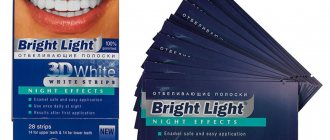Author of the article:
Soldatova Lyudmila Nikolaevna
Candidate of Medical Sciences, Professor of the Department of Clinical Dentistry of the St. Petersburg Medical and Social Institute, Chief Physician of the Alfa-Dent Dental Clinic, St. Petersburg
Over time, teeth acquire an increasingly distinct yellow tint, which is not to everyone’s taste, because it is difficult to come up with something more bewitching and attractive than a snow-white smile. Unfortunately, achieving, and most importantly, maintaining it is not so easy - there are so many temptations around. Coffee, tea, wine, berries, lemonades and other products significantly affect the color of enamel. The situation is aggravated by smoking, as well as poor oral hygiene.
If you notice that your teeth have become darker and want to correct it, don’t despair. Today there are many convenient and affordable ways to solve this problem. One of the most popular options among home procedures is whitening using special strips. Their advantages are simplicity, safety, relatively low price and the ability to take everything you need for the procedures with you, for example, on a business trip.
But before you start whitening, you need to familiarize yourself with the rules for using strips. This will not only help you avoid common mistakes, but will also increase the effect of these funds.
We suggest you read some simple but important tips.
How to whiten teeth correctly?
Step one: read the instructions
Be sure to pay attention to what is written in the instructions, even if this is not your first time doing whitening. Most products have similar methods of use, but due to the difference in composition there may be some differences in use. Therefore, read the instructions to the very end, paying special attention to possible side effects.
- Remember that improper use of any whitening products is dangerous to the health of your teeth. The fact is that the process itself causes weakening of the enamel, so you need to approach it carefully. The active substance applied to the strips may cause soft tissue irritation and other problems.
- Different brands of strips have different instructions, so every time you use a product from a new manufacturer, read the manual carefully.
Step two: brush your teeth
Before you begin whitening, brush your teeth thoroughly, otherwise food debris and plaque will prevent you from achieving good results.
Important:
- Do not whiten your teeth immediately after brushing them; do this at least half an hour after the procedure.
If you want to achieve maximum results, it is better to have the cleaning done by a dentist. There are several procedures that will help restore teeth to their natural color and get rid of hard and soft plaque. The most popular options: ultrasonic cleaning and cleaning using an Air Flow device. The first is necessary if you have tartar. The second is a more gentle procedure; food debris and soft plaque are removed using a special abrasive solution, which is released under pressure.
Step Three: Prepare the Strips
Before you fix the strips, make sure you are using them correctly. Some manufacturers produce strips of various shapes for the upper and lower teeth. In other cases, the products do not differ from each other. Be sure to figure this out when you decide to whiten.
- After you understand how to properly fix the elements, prepare the strips. The composition contains an active substance, most often it is based on hydrogen peroxide. The principle of operation is simple - oxygen is gradually released from peroxide, which penetrates the enamel, discoloring the pigment.
- The smooth side does not contain active gel; its main function is to make it convenient for you to stick the strips to your teeth.
Step Four: Apply the strips to your teeth
- Apply the strip to the front surface of your teeth with the gel side so that it completely covers the teeth, then smooth out any irregularities.
- In order to straighten the strip, it is convenient to use a toothbrush.
- Make sure that the strip actually covers the entire row of teeth, if you, of course, want to get a uniform result.
- Try not to get the gel on your gums, especially during the period of wisdom teeth eruption, otherwise perioronitis may occur; if necessary, remove it with a cotton swab, as long-term presence of the active substance on soft tissues can cause irritation.
Step Five: Wait
After both strips are attached to the teeth, all that remains is to wait a little. Do not touch the strip for the process to proceed correctly. The required time depends on the concentration of the active substance and other factors. Therefore, be sure to read the instructions carefully to correctly determine how long you will need to wait. Usually the session lasts about half an hour, after which you can remove the strips.
Step Six: Remove the Strips
- After the waiting time has passed, you need to carefully remove the strips. Slowly peel them off the enamel surface and discard.
- Carefully watch the clock so as not to overexpose the gel on your teeth. This can lead to damage to the enamel or irritation of the gums, and the delay can also increase tooth sensitivity.
- Remember that if you leave the strips on longer, the effect will not become more noticeable.
- Be sure to rinse your mouth after removing the whitening strips. After this, to completely remove any remaining gel, brush your teeth with a toothbrush.
Seventh step: repeat the procedure
Unlike in-office whitening, home remedies never provide instant results. Therefore, to make your teeth whiter, you will have to undergo several procedures. The gel that is applied to the strips has a small concentration of the active substance, which is why the lightening is not immediately noticeable. But this also has its advantages, since the process becomes less destructive to the enamel. Remember that quality whitening requires patience. To obtain a noticeable effect, you will need to carry out several procedures. They should be repeated in accordance with the rules written in the instructions.
- In most cases, you will need to do the procedure for 30 minutes twice a day.
- The minimum recommended period for using whitening strips is 14 days.
- The results become noticeable approximately four months after you start the procedure.
PROFESSIONAL SELECTION OF CREST WHITESTRIPS WHITENING STRIPS
The choice of whitening strips Crest 3D White Whitestrips primarily depends on what whitening result you want to achieve? The more effective the whitening system, the better the whitening result. If you have never whitened your teeth before, but want to try and a slight lightening of the enamel of your teeth by a few tones is enough for you, then the simplest system “for beginners” will suit you. If you initially want to achieve the best results, we recommend choosing strips from the professional Crest Whitestrips .
Some people believe that the simpler the whitening system, the less harmful it is to tooth enamel - this is a misconception. Remember that any Crest Whitestrips is absolutely safe for the health and enamel of teeth when used correctly according to the instructions!
For your convenience, there are many filters in the product category, with which you can easily choose a whitening system based on your wishes and needs!
Precautionary measures
- Never swallow the gel. Most whitening strips are coated with a chemical composition in which the active ingredient is hydrogen peroxide. It is a highly toxic substance that can cause soft tissue irritation and other problems. Therefore, be careful not to swallow the gel while you are gluing or removing the strips. At the same time, if you accidentally swallowed a small amount of peroxide, do not panic, it will not cause serious consequences (in small quantities).
- Stop the procedure if you feel pain or increased tooth sensitivity. The active substances contained in the whitening composition can cause discomfort in the teeth and gums. This usually happens if you use this whitening method too often or leave the strips on for too long. In addition, troubles can occur if you have caries or your teeth are hypersensitive to the substances that make up the gel. As soon as you notice something wrong, stop using the strips and contact your dentist for advice. A specialist will select more suitable procedures for you and help restore damaged enamel.
- It is advisable that you consult your doctor before you decide to undergo whitening. This cosmetic procedure has a rather serious impact on dental health, which is why it is not suitable for everyone. You may be better off sticking with in-office teeth cleanings.
- It is also advisable to consult a doctor if you decide to switch to strips from another manufacturer. Here you need to find out whether the new product is right for you.
Dental care
- If you want your teeth to be healthy and the whitening effect to last as long as possible, take proper care of your entire oral cavity. This should be done as often as possible, spending sufficient time brushing your teeth.
- Brush your teeth at least twice a day, for about two to three minutes.
- It is important to clean carefully so as not to damage the gums and enamel.
- To make the whitening effect more noticeable, use a special whitening paste, for example, ASEPTA PLUS GENTLE WHITENING. It not only cleanses the surface of pigment, but also prevents increased sensitivity of tooth enamel, and the calamus and eleutherococcus extracts included in the composition promote accelerated gum regeneration, prevent bleeding and inflammation.
- In addition to regular brushing, use mouthwash; it has a good antiseptic effect, which significantly improves the condition of your gums and teeth. The solutions contain natural ingredients that prevent inflammation of soft tissues and reduce sensitivity
- Rinse your teeth for at least 30 seconds, then spit out the liquid.
- If you think the rinse aid is too concentrated, dilute it with water according to the instructions.
- If you want to enhance the effect of the strips, use special whitening rinses.
- Don't give up on flossing. With its help, you can better remove food debris from your teeth, which will reduce the accumulation of soft plaque and reduce the likelihood of tartar formation. The procedure is quite simple:
- Tear off a piece of thread approximately the length of your arm.
- Wrap the ends of the thread around the middle or index fingers of your left and right hands.
- Gently lower the floss into the space between your teeth.
- When it reaches the surface of the gum, wrap the floss around one of your teeth and gently rub it over the surface of the tooth, moving up and down.
- Do this with each tooth.
- Try to exclude coloring drinks and food from your diet during the procedures, otherwise you will not soon notice the effect. Or you risk not getting it at all. Eliminate the following foods from your diet:
- Coffee, tea, wine;
- Colored lemonades;
- Berries: blueberries, blackberries, etc.
- Chocolate;
- Lemons and oranges, as well as other foods with high acidity.
- Visit your dentist regularly.
Sources:
- Report on determining/confirming the preventive properties of toothpaste “ASEPTA PLUS” GENTLE WHITENING” Author: doctor-researcher A.A. Leontyev, head Department of Preventive Dentistry, Doctor of Medical Sciences, Professor S.B. Ulitovsky First St. Petersburg State Medical University named after. acad. I.P. Pavlova, Department of Preventive Dentistry
- Clinical and laboratory assessment of the influence of domestic therapeutic and prophylactic toothpaste based on plant extracts on the condition of the oral cavity in patients with simple marginal gingivitis. Doctor of Medical Sciences, Professor Elovikova T.M.1, Candidate of Chemical Sciences, Associate Professor Ermishina E.Yu. 2, Doctor of Technical Sciences Associate Professor Belokonova N.A. 2 Department of Therapeutic Dentistry USMU1, Department of General Chemistry USMU2
- Report on the determination/confirmation of the preventive properties of personal oral hygiene products “ASEPTA PLUS” Remineralization doctor-researcher A.A. Leontyev, head Department of Preventive Dentistry, Doctor of Medical Sciences, Professor S.B. Ulitovsky First St. Petersburg State Medical University named after. acad. I.P. Pavlova, Department of Preventive Dentistry
- Clinical studies of antisensitive toothpaste “Asepta Sensitive” (A.A. Leontyev, O.V. Kalinina, S.B. Ulitovsky) A.A. LEONTIEV, dentist O.V. KALININA, dentist S.B. ULITOVSKY, Doctor of Medical Sciences, Prof. Department of Therapeutic Dentistry, St. Petersburg State Medical University named after. acad. I.P. Pavlova
- Report on determining/confirming the preventive properties of toothpaste “ASEPTA PLUS” COFFEE and TOBACCO Author: doctor-researcher A.A. Leontyev, head Department of Preventive Dentistry, Doctor of Medical Sciences, Professor S.B. Ulitovsky. First St. Petersburg State Medical University named after. acad. I.P. Pavlova, Department of Preventive Dentistry
- Report on determining/confirming the preventive properties of commercially produced personal oral hygiene products: Asepta toothpaste used in combination with Asepta mouthwash and Asepta gum balm Head. Department of PFS Doctor of Medical Sciences Professor S.B. Ulitovsky St. Petersburg State Medical University named after Academician I.P. Pavlova. Faculty of Dentistry. Department of Preventive Dentistry.
What are the strips and what is included in the kit?
The width of the teeth cleaning strip is sufficient to cover the visible and hidden sides of one row of teeth. In standard packaging there are usually two types of such plates - a shortened one for the lower jaw and an elongated one for the upper jaw. On one side, the overlay is treated with a special brightening gel designed for direct contact with the enamel surface. The composition is completely harmless, but only if there are no problems with teeth or inflammatory dental diseases. Therefore, before using the method, you must visit your dentist and make sure that you have no contraindications to the use of strips.
The photo shows teeth whitening strips
The best systems from AliExpress with whitening gel
A teeth whitening system is a kit that consists of a gel or strips containing at least 10% carbamide or hydrogen peroxide, an LED or infrared lamp and a custom tray. Whitening occurs due to the release of active oxygen under the influence of light radiation from a lamp.
The bleach is applied using a tray, then the lamp is turned on. The enamel pores open, active oxygen penetrates inside and removes darkening. After the procedure, the dentinal tubules remain open, so some manufacturers complete kits with products containing minerals that strengthen the enamel (hydroxyapatite, calcium, potassium, magnesium).
Advantages
Lamellar products for enamel whitening are attractive for many reasons:
- they are easy to use, so they can be used independently;
- allow you to quickly get the desired result;
- do not destroy enamel;
- safe to use;
- the result lasts for a long time (up to 1.5 years).
Advantages and disadvantages
Home whitening techniques have many undeniable advantages. Thus, the best strips from leading brands are characterized by the following advantages:
- simplicity and ease of the procedure,
- the ability to get quick results,
- safety for enamel (if everything is fine with the teeth initially),
- lasting effect - up to a year,
- no unpleasant or painful sensations during whitening,
- the ability to lighten the enamel by 4-5 tones,
- affordable cost when compared with a similar procedure at the dentist's office.
“I hesitated for a long time to try home whitening methods, until a good friend started praising Crest strips. In general, after talking with my dentist, I also decided to try them. The effect was simply amazing. True, at first my teeth were very sensitive, but then everything went away. Now they will definitely take the course every six months.”
Olga R., Kaliningrad, from correspondence on the forum
This method is very easy to use.
As for the disadvantages of the method, there are not so many of them. The first and most common inconvenience that patients have to face is hyperesthesia, that is, increased susceptibility of the enamel to mechanical stimuli and temperature changes. It is also important to distribute the strip evenly across the row, otherwise you may get a “spotty” effect. Sometimes the individual characteristics of the enamel layer do not allow achieving the desired result. There is also a possibility of developing an allergic reaction to the components of the composition used. First, you should definitely consult a doctor - whitening can only be done on healthy and strong teeth.
Indications for use
- naturally yellow or even grayish color of enamel,
- pigmentation as a result of smoking and frequent consumption of coloring drinks, such as tea or coffee,
- change in tooth color after removal of orthodontic structures,
- long-term use of powerful medications, which led to darkening of the enamel,
- the desire to make your smile snow-white without visiting a specialist’s office.
Teeth darkened by external factors - an indication for using the method
The principle of operation of the product
Whitening strips are impregnated with a special composition containing peroxides - a thin transparent film protects it from contact with the environment. Immediately after its removal, the active release of oxygen ions begins, which provoke oxidative reactions. Organic compounds on the enamel are destroyed, splitting into water and carbon dioxide. As a result, it is possible to eliminate pigmentation and make teeth noticeably whiter. It should be noted that the in-office procedure is carried out according to the same principle, with the only difference being that the active components of the product used are activated under the influence of special light or laser.
Can they harm enamel?
First of all, the enamel may be damaged, but this only happens with cheap, low-quality products and when the technology for conducting whitening sessions is violated. Before starting the course, you need to visit the dentist and make sure that your teeth are completely healthy.
When using a gel with an increased concentration of the active substance, hyperesthesia may be observed, that is, increased sensitivity of the enamel when it begins to react sharply to hot and cold food or drinks, sudden temperature changes in food, as well as chemical food irritants - too salty or, for example, sour products. Usually the discomfort goes away after 3-4 sessions, but if the discomfort only intensifies, you need to urgently stop whitening and make an appointment with a dentist.
Comparison table of characteristics
In order to compare the presented products, we recommend that you study the table with characteristics in the article below.
| Model | Duration of procedure (min) | Course duration (days) | Whitening tone | Price, rub) |
| Crest 3D White Gentle Routine | 30 | 14 | 1-2 | from 3190 to 5600 |
| Crest 3D White Glamorous White | 30 | 14 | 4 | from 3590 to 5780 |
| Crest 3D White Professional Effects | 30 | 20 | 5 | from 4700 to 6800 |
| Crest 3D White Supreme FlexFit | 60 | 21 | 5 | from 2399 to 4500 |
| Crest Supreme Professional Whitening | 30 | 21 | 6-7 | from 5990 to 7800 |
| Crest 3D White Classic Vivid | 30 | 10 | 2-3 | from 2590 to 3690 |
| Crest 3D White With Light | 60 | 10 | 8 | from 6290 to 8700 |
| Global White Charcoal | 30 | 7 | 3 | from 799 to 1200 |
| Blend-a-med 3D White Luxe | 30 | 7 | 5-6 | from 2600 to 3010 |
| My Brilliant Smile based on activated carbon and coconut oil | 30 | 7 | 10 | from 2350 to 4000 |
What are the restrictions on use?
Before moving on to the question of how to use strips, you need to say a few words about contraindications to this method of whitening. Firstly, this method is not suitable for women during pregnancy and breastfeeding. Children under 18 years of age and patients suffering from pathologies of periodontal tissue and inflammation in the gums are prohibited from using the strips. Secondly, such whitening cannot be carried out if there are crowns, fillings, or fixed dentures in the smile area - they will not change their color and can then stand out strongly. It is contraindicated to use this method in case of intolerance to the components of the product used, as well as in severe systemic diseases such as epilepsy, bronchial asthma, hypertension.
What effect to expect
According to user reviews, the effect becomes noticeable after 3 sessions, and lasting results can be achieved after 10-14 days of regular procedures. With the help of such strips, you can make the enamel whiter by 1-6 tones - it all depends on the intensity of exposure to the brightening gel and the duration of the course. 1. An activator gel with a low concentration of hydrogen peroxide whitens gradually, usually by 1-4 tones. Products with a high content of active ingredients offer a faster and more pronounced effect - 5-7 tones.
When bleaching with strips, you can achieve lightening of up to 5-7 tones.
What types of whitening strips are there?
The range of brightening products for home whitening is constantly expanding, and today you can purchase a kit for a snow-white smile in almost every pharmacy. This standard set usually includes 2 films - for each jaw. It should be noted right away that this technique is designed to treat only the smile zone, so it is unlikely that it will be possible to lighten the back teeth.
So, currently on pharmacy shelves you can find the following types of whitening strips:
- delicate - aimed at people with increased sensitivity of enamel and, accordingly, its acute susceptibility to temperature changes in food and drinks, sour, sweet foods,
- standard is the best option for people without severe dental problems, with healthy teeth and gums,
- enhanced action - used mainly for emergency elimination of bacterial plaque and urgent lightening of enamel. Such kits contain an activator with a high concentration of the active substance,
- supporting – indicated to consolidate and prolong the achieved effect.
There are also certain types of strips that completely dissolve - there is no need to remove them at the end of the session. However, more often than not, manufacturers still produce strips with a removable film designed to protect the mucous membrane from chemical irritation. There are also options for quick and long exposure. The first offer an almost instant effect, however, the side effects of such bleaching can be much greater.









